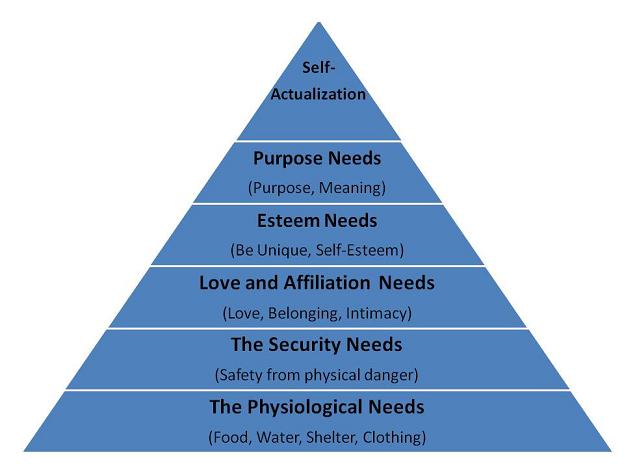American psychologist Abraham Maslow pioneered an approach to understanding human behavior that he called “Humanistic Psychology”. He believed that every person has a strong desire to reach his or her full potential, which he referred to as “self-actualization”.
Maslow’s insights into human nature quickly allowed him to realize that self-actualization was not the most pressing need for human beings. This led him to create his most famous contribution to psychology, now commonly referred to as Maslow’s Hierarchy of Needs, illustrated below.
As can be seen from the graphic, Maslow represented the basic levels of human needs in a pyramid, or hierarchy. The needs flow from the most basic survival requirements, such as food, water, and shelter, to the pinnacle, which Maslow referred to as self-actualization.
So what does this have to do with marketing? In reality, you should always bear this hierarchy in mind when you are marketing or selling anything. It is fundamental to try to understand where your audience falls on this hierarchy, whether you are selling to an individual in-person, or marketing to a large group of people dispersed across a wide geographic area. Either way, presumably you are marketing to human beings, all of whom are impacted by the Hierarchy of Needs and whose behavior will be greatly affected by where they fall on the pyramid at a particular point in time. Let’s look at some examples to further understand this.
The first example we’ll look at is an extreme one. Let’s say that you decide to make a foray into Africa with your marketing, as you’ve been told that the self-improvement program that you sell could likely help the people of, let’s say several countries in Sub-Saharan Africa, find their way out of poverty. So, you put together a seminar and begin to advertise it throughout the region. You quickly realize that the only responses you are getting are from a few government officials and members of wealthier families in the area. You have wasted money on marketing and realize that your foray into Africa, at least the way you approached it, was a failure. So what happened? The answer is quite obvious: you were trying to market a self-actualization product to a target population, a large portion of which has not even satisfied their most basic physiological and security needs.
Now let’s take a less obvious example, which also illustrates the importance of “niche” markets and market segmentation. Let’s say that you sell electronic security systems and monitoring services. You decide that based on the demographics of a certain part of your city, you will focus your marketing efforts in that area. One of your prime indicators is that the area has a lot of families and you know that on average, families with children are very concerned about safety. There are several small, affluent neighborhoods in the area you’re looking at. Given that the demographics are similar, you don’t think it matters much which one you use for your test, so you choose neighborhood A. As it so happens, a competitor is thinking along the same lines and chooses neighborhood B, which is very similar, but a couple miles down the road. You run your test and achieve a 10% success rate on a key sales metric. You later find out that, using exactly the same marketing approach, your competitor achieved a 30% success rate in neighborhood B, a couple miles down the road!
So what happened? Your product and service offerings are very similar. Past experience has proved that your sales forces are roughly equal in closing skill. Your marketing materials are virtually undiffferentiable. You ran your tests at almost exactly the same time. What was the difference that caused your competitor to have a result 3 times better than yours? You may have already figured it out – neighborhood B had had a rash of home robberies in recent months, so the residents there were very concerned about the Safety Need referred to on Maslow’s Hierarchy of Needs. The residents in Neighborhood A had not had a robbery in their immediate area in over 5 years. Maybe your competitor got lucky, or maybe they did their homework, but either way, they achieved much greater results because the market they targeted had an immediate need for what they were offering, due to a pressing concern to satisfy their Safety Need.
This second example also illustrates that it is not just important to bear the Hierarchy of Needs in mind in your product creation, marketing and sales efforts, but also remember that the consumer is focused on satisfying immediate needs, particularly at the lower end of the pyramid. In fact, regardless of where someone may fall on the pyramid, the reality is that the majority of the time, they are focused on satisfying relatively short term needs. Sure, there are some “planners” out there, particular those who at the present time fall higher up on the pyramid, but the vast majority of customers and clients you are likely to target, spend most of their time trying to satisfy immediate or relatively short-term needs. This is true whether they’re focused on physiological needs, safety needs, affiliation needs, esteem needs, or even purpose needs. If it’s not immediate or urgent in their minds, most likely it gets demoted in favor of something that is more pressing. Bear this in mind in your marketing and other persuasion efforts; you must not only hit the target with the right message for where they are in the Hierarchy, you must also try to hit them at the right time. If you don’t, as the saying goes, your message is likely to go “in one ear and out the other”. Since it’s tough to predict the exact correct moment, this is an argument for having ongoing and frequent interaction with prospects, obviously without overdoing it to the point that they just “shut you off,” in order to increase the probability that your message will be in front of them at that moment when the need your offering can satisfy becomes immediate or urgent for them.
Keep Maslow in mind as you go about your business. If you have comments or questions, we’d love to hear them. Leave a comment below or in the top right corner of this post.
Paul Morin
CompanyFounder.com
Twitter: @companyfounder
paul@CompanyFounder.com.




I think here in the U.S. we are pretty lucky; we have most of our basic needs and thus we look to satisfy our wants. I think a lot of products are marketed to Maslow’s levels of Love and Affiliation and Esteem. I believe this because you are lead to believe if you buy said product you will fit in with your friends thus gain their love because of a shared product or you will have the product that no one else has and thus stand out leading to a higher self esteem. For Instance take the Iphone; its a newer technology piece that is still a bit out of reach for some people so people who have them are in a league of the “elite” so they can pride themselves on having the latest and greatest. Having the greatest makes them feel potentially superior which wouldn’t you agree leads to a higher self worth? Or take the Axe shower gel ads; you often see a guy without it portrayed as lonely and a “loser.” Then suddenly he gets Axe and suddenly the girls are swarming him. He now has constant attention and that leads to a feeling of being wanted and loved. This article is very well written and I do believe that it is necessary if you are in the market to sell something that you do your research and know who your target audience is and what their specific needs are. Thanks to Maslow it is now easier to understand the basic human needs and how to better relate to the consumers.
I think your comment is dead-on. The examples you use illustrate exactly how an understanding of Maslow’s Hierarchy of Needs is fundamental to being a good marketer. Your point about the U.S., on average, being further up the Hierarchy is also well-taken. In reality, a lot of the foundation for classifying countries as “First World”, “Second World”, “Third World” can be tied back to Maslow’s Hierarchy. Thanks for your insightful comment. I hope Maslow serves you well in your marketing. Paul
Great article. I blogged about it at http://www.thetimeshareauthority.com because I saw how clearly it reinforces why people seek vacation oasis in their lives.The need for gifting our families with a vacation experience, indulging our need to feel pampered, living an identity as one who deserves to be in resorts and desirable destinations…. it all reflects the hierarchy. In many ways the role of marketing for vacation products is to help people visualize themselves in the setting and understand that wanting to experience holiday and vacation time is natural and necessary in the human psyche.